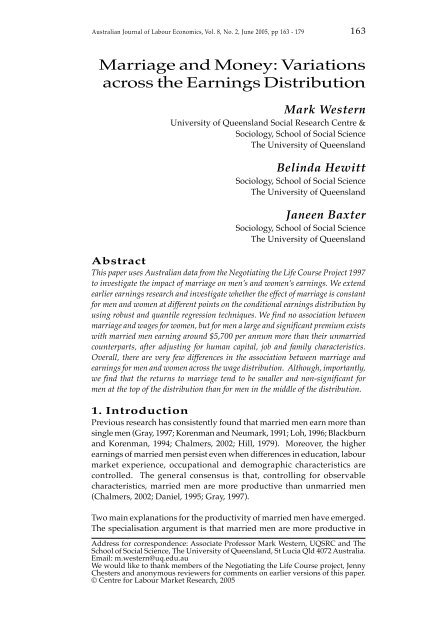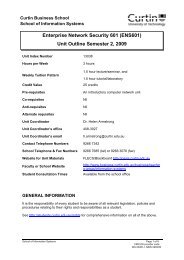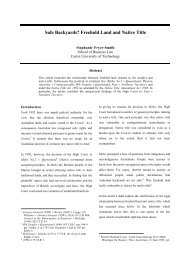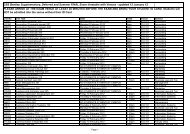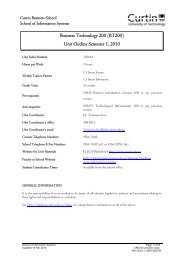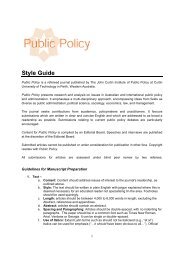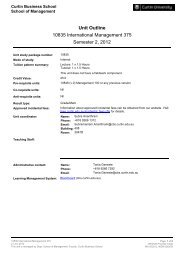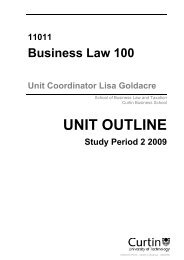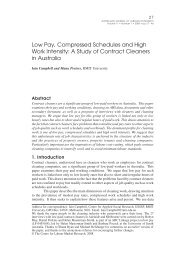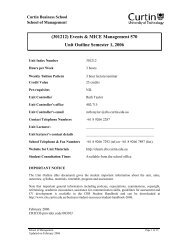Marriage and Money: Variations across the Earnings ... - UQ eSpace
Marriage and Money: Variations across the Earnings ... - UQ eSpace
Marriage and Money: Variations across the Earnings ... - UQ eSpace
- No tags were found...
Create successful ePaper yourself
Turn your PDF publications into a flip-book with our unique Google optimized e-Paper software.
Perry Australian & Wilson: Journal of The Labour Accord Economics, <strong>and</strong> Strikes Vol. 8, No. 2, June 2005, pp 163 - 179163<strong>Marriage</strong> <strong>and</strong> <strong>Money</strong>: <strong>Variations</strong><strong>across</strong> <strong>the</strong> <strong>Earnings</strong> DistributionMark WesternUniversity of Queensl<strong>and</strong> Social Research Centre &Sociology, School of Social ScienceThe University of Queensl<strong>and</strong>Belinda HewittSociology, School of Social ScienceThe University of Queensl<strong>and</strong>Janeen BaxterSociology, School of Social ScienceThe University of Queensl<strong>and</strong>AbstractThis paper uses Australian data from <strong>the</strong> Negotiating <strong>the</strong> Life Course Project 1997to investigate <strong>the</strong> impact of marriage on men’s <strong>and</strong> women’s earnings. We extendearlier earnings research <strong>and</strong> investigate whe<strong>the</strong>r <strong>the</strong> effect of marriage is constantfor men <strong>and</strong> women at different points on <strong>the</strong> conditional earnings distribution byusing robust <strong>and</strong> quantile regression techniques. We find no association betweenmarriage <strong>and</strong> wages for women, but for men a large <strong>and</strong> significant premium existswith married men earning around $5,700 per annum more than <strong>the</strong>ir unmarriedcounterparts, after adjusting for human capital, job <strong>and</strong> family characteristics.Overall, <strong>the</strong>re are very few differences in <strong>the</strong> association between marriage <strong>and</strong>earnings for men <strong>and</strong> women <strong>across</strong> <strong>the</strong> wage distribution. Although, importantly,we find that <strong>the</strong> returns to marriage tend to be smaller <strong>and</strong> non-significant formen at <strong>the</strong> top of <strong>the</strong> distribution than for men in <strong>the</strong> middle of <strong>the</strong> distribution.1. IntroductionPrevious research has consistently found that married men earn more thansingle men (Gray, 1997; Korenman <strong>and</strong> Neumark, 1991; Loh, 1996; Blackburn<strong>and</strong> Korenman, 1994; Chalmers, 2002; Hill, 1979). Moreover, <strong>the</strong> higherearnings of married men persist even when differences in education, labourmarket experience, occupational <strong>and</strong> demographic characteristics arecontrolled. The general consensus is that, controlling for observablecharacteristics, married men are more productive than unmarried men(Chalmers, 2002; Daniel, 1995; Gray, 1997).Two main explanations for <strong>the</strong> productivity of married men have emerged.The specialisation argument is that married men are more productive inAddress for correspondence: Associate Professor Mark Western, <strong>UQ</strong>SRC <strong>and</strong> TheSchool of Social Science, The University of Queensl<strong>and</strong>, St Lucia Qld 4072 Australia.Email: m.western@uq.edu.auWe would like to thank members of <strong>the</strong> Negotiating <strong>the</strong> Life Course project, JennyChesters <strong>and</strong> anonymous reviewers for comments on earlier versions of this paper.© Centre for Labour Market Research, 2005
164Australian Journal of Labour Economics, June 2005<strong>the</strong> labour market due to role specialisation in households. In marriedhouseholds women specialize in domestic duties <strong>and</strong> men specialize in <strong>the</strong>labour market, enabling married men to be more productive at work thanunmarried men. The second explanation is that <strong>the</strong>re are selection effectswhereby <strong>the</strong> unobservable characteristics of men that are valued in <strong>the</strong>marriage market are also valued in <strong>the</strong> labour market. Under this scenariomen who are successful in <strong>the</strong> labour market are also more likely to marry.While evidence has been found for both explanations, on balance, <strong>the</strong>available research tends to favour specialisation with <strong>the</strong> gender divisionof labour in <strong>the</strong> household allowing a married man <strong>the</strong> time <strong>and</strong> energy topursue labour market goals (Becker, 1985; Blackburn <strong>and</strong> Korenman, 1994;Chalmers, 2002; Gray, 1997; Korenman <strong>and</strong> Neumark, 1991; Loh, 1996).For women, <strong>the</strong> relationship between marriage <strong>and</strong> earnings is morecomplex. The findings of previous studies have been mixed, <strong>and</strong> sometimescontradictory (Budig <strong>and</strong> Engl<strong>and</strong>, 2001; Dolton <strong>and</strong> Makepeace, 1987;Goldin <strong>and</strong> Polachek, 1987; Gray, 1997; Hill, 1979; Waldfogel, 1997). Earlyresearch investigating <strong>the</strong> relationship between marriage <strong>and</strong> women’searnings found little or no association (Dolton <strong>and</strong> Makepeace, 1987; Goldin<strong>and</strong> Polachek, 1987; Hill, 1979), whereas more recent studies, usinglongitudinal data, have found significant positive associations (Budig <strong>and</strong>Engl<strong>and</strong>, 2001; Waldfogel, 1997). Moreover, studies investigating <strong>the</strong>determinants of women’s earnings tend to find a significant wage penaltyfor mo<strong>the</strong>rhood, where mo<strong>the</strong>rs earn less than non-mo<strong>the</strong>rs, ra<strong>the</strong>r than astrong association between marriage <strong>and</strong> earnings (Budig <strong>and</strong> Engl<strong>and</strong>,2001; Harkness <strong>and</strong> Waldfogel, 1999; Korenman <strong>and</strong> Neumark, 1992;Waldfogel, 1997). The evidence suggests <strong>the</strong>n that marriage may increasewomen’s earnings, but this pattern is strongly counter-balanced by <strong>the</strong>negative impact of mo<strong>the</strong>rhood.Despite <strong>the</strong> burgeoning literature examining <strong>the</strong> association betweenmarriage <strong>and</strong> earnings, especially for men, very little is known about <strong>the</strong>association between marriage <strong>and</strong> earnings at varying points on <strong>the</strong>distribution. In this study we investigate <strong>the</strong> relationship between marriage<strong>and</strong> earnings for both men <strong>and</strong> women. We extend earlier research bycomparing <strong>the</strong> effect of marriage at different points on <strong>the</strong> earningsdistribution using quantile regression methods. This is important becauseboth <strong>the</strong> specialisation <strong>and</strong> selection hypo<strong>the</strong>ses can be qualified to implydifferent marriage premiums depending on where on <strong>the</strong> incomedistribution we examine <strong>the</strong> relationship.2. The <strong>Marriage</strong> Premium for MenThere are several reasons to believe that <strong>the</strong> association between earnings<strong>and</strong> marriage for men may differ depending on where <strong>the</strong>y are situatedwithin <strong>the</strong> earnings distribution. For instance, if specialisation benefits are<strong>the</strong> primary mechanism for <strong>the</strong> association between marriage <strong>and</strong> earningsfor men one might expect similar returns to marriage for men at all pointson <strong>the</strong> distribution. Feminist research has long recognised <strong>the</strong>‘incorporation’ of wives into husb<strong>and</strong>s’ work <strong>and</strong> <strong>the</strong> importance of <strong>the</strong>irrole as providers of domestic labour, emotional support <strong>and</strong> in some cases,
Western, Hewitt & Baxter: <strong>Marriage</strong> <strong>and</strong> <strong>Money</strong>: <strong>Variations</strong> <strong>across</strong> <strong>the</strong><strong>Earnings</strong> Distribution165a direct contribution to <strong>the</strong> husb<strong>and</strong>s job through a range of essential, butunpaid activities, such as entertaining clients, secretarial work <strong>and</strong> accountkeeping(Finch, 1983; Delphy <strong>and</strong> Leonard, 1992). In Married to <strong>the</strong> Job Finchargues that this kind of incorporation is not restricted to wives ofprofessional workers, but ra<strong>the</strong>r extends <strong>across</strong> <strong>the</strong> occupational structureto include wives of those employed in services, trades <strong>and</strong> manual work.In arguing for specialisation effects associated with marriage, Daniel (1995)came up with <strong>the</strong> term augmentation capital to describe <strong>the</strong> ability of a wifeto enhance her husb<strong>and</strong>’s productivity in <strong>the</strong> work place by providing aflow of services ranging from organising activities, running err<strong>and</strong>s,performing housework, <strong>and</strong> o<strong>the</strong>r household chores. He argues that evenwhen a woman marries a man with lower earnings, she is still likely tohave augmentation capital <strong>and</strong> provide her husb<strong>and</strong> with a marriagepremium (Daniel, 1995: 119). Under this scenario returns to marriage wouldbe expected to differ depending on <strong>the</strong> degree of specialisation within <strong>the</strong>household. However, since augmentation capital contributes directly tomen’s productivity we can also qualify <strong>the</strong> st<strong>and</strong>ard specialisation argumentto anticipate larger premiums at <strong>the</strong> top of <strong>the</strong> earnings distribution than at<strong>the</strong> middle or bottom. If, as human capital <strong>the</strong>ory argues, earnings reflectmarginal productivity, we can think about augmentation capital asenhancing <strong>the</strong> marginal productivity of <strong>the</strong> ‘last’ married employee, relativeto <strong>the</strong> ‘last’ nonmarried employee. Enhanced marginal productivityassociated with augmentation capital may arise because married men havemore time to devote to paid work than single men, are able to commit morefully to it in o<strong>the</strong>r ways (such as psychologically or emotionally), or havegreater flexibility with respect to paid work than single men, so that <strong>the</strong>yare better able to adjust to changing work dem<strong>and</strong>s. In all <strong>the</strong>se cases though,we might expect that <strong>the</strong> additional ‘effort’ married men are able to makein paid work by comparison to single men translates into a larger premiumat <strong>the</strong> top of <strong>the</strong> earnings distribution, ei<strong>the</strong>r because it does genuinelyimply a greater difference in <strong>the</strong> marginal productivity of married <strong>and</strong> singlemen in highly paid jobs, compared to those in lower paid jobs, or because itis associated with employers’ perceptions of greater productivitydifferences. Differences in effort between those in highly paid jobs are likelyto be associated with larger earnings differentials than similar differencesin effort among those in lower paid jobs because productivity differences(real or perceived) are larger in <strong>the</strong> former case. We refer to this as <strong>the</strong>earnings enhanced specialisation argument, in contrast to <strong>the</strong> st<strong>and</strong>ardspecialisation argument, which implies a constant premium <strong>across</strong> <strong>the</strong>earnings distribution.If selection factors are <strong>the</strong> primary force underlying <strong>the</strong> marriage premium,one might also expect that men at <strong>the</strong> top of <strong>the</strong> earnings distribution wouldhave a larger premium than men at <strong>the</strong> lower end because men who earnmore money are more likely to be married (Becker, 1981). Prior studiesprovide evidence for this scenario. For example, Nakosteen <strong>and</strong> Zimmer(1997), using <strong>the</strong> 1979, 1982 <strong>and</strong> 1984 waves of <strong>the</strong> Panel Study on IncomeDynamics investigated <strong>the</strong> probability of marriage for single men who hadabove average earnings <strong>and</strong> found that those with higher than expected
166Australian Journal of Labour Economics, June 2005earnings were significantly more likely to marry within <strong>the</strong> study timeframe. Selectivity implies that unmeasured characteristics that are valuablefor both marriage <strong>and</strong> employment explain <strong>the</strong> marriage premium for men.The likely mechanism here is that employers use marriage as an indicatorof o<strong>the</strong>r desirable characteristics that employees possess. In highly paidjobs, being unmarried may <strong>the</strong>refore carry a greater ‘penalty’ since it signals<strong>the</strong> absence of such characteristics more strongly in a pool where a higherproportion of men are married. We describe this as <strong>the</strong> earnings enhancedselection effect to contrast it against <strong>the</strong> st<strong>and</strong>ard selection argument of aconstant marriage premium.3. <strong>Marriage</strong> <strong>and</strong> Women’s <strong>Earnings</strong>Early research examining <strong>the</strong> determinants of women’s earnings found thatmarriage had little or no association once adjustments were made for humancapital (education, work experience, tenure), job characteristics (hoursworked, occupation, employment conditions), <strong>and</strong> family status (<strong>the</strong>presence or number of children). For example, Hill (1979) using data from<strong>the</strong> 1976 Panel Study of Income Dynamics found no significant associationbetween marriage <strong>and</strong> wages. Controlling for education, work experience<strong>and</strong> number of children, her results show that married, white women earnmore than unmarried women, but less than divorced, separated or widowedwomen. Dolton <strong>and</strong> Makepeace (1987) also found no association betweenmarriage <strong>and</strong> wages among female college graduates. Goldin <strong>and</strong> Polachek(1987), on <strong>the</strong> o<strong>the</strong>r h<strong>and</strong>, using 1980 U.S. Census data found that singlewomen had a wage advantage over married women, but <strong>the</strong>se differenceswere small once adjustments were made for variability in expected levelsof accumulated human capital.More recent investigations have focused specifically on <strong>the</strong> wage penaltyfor mo<strong>the</strong>rhood. Budig <strong>and</strong> Engl<strong>and</strong> (2001) used <strong>the</strong> National LongitudinalSurvey for Youth, 1982-1993, <strong>and</strong> adjusting for a wide range of humancapital, family, <strong>and</strong> job characteristics, found a marriage premium forwomen of around 4 per cent. They also found that being divorced, separated,<strong>and</strong> widowed had a large positive effect on women’s earnings comparedto being married or never married. Waldfogel (1997) also found a marriagepremium for women, but found that divorced, separated <strong>and</strong> widowedwomen had higher earnings than both married <strong>and</strong> never married women.A possible explanation for <strong>the</strong> consistent finding <strong>across</strong> both studies thatwomen who are divorced, separated, <strong>and</strong> widowed usually have higherwages than married women is that previously married women move into<strong>the</strong> workforce out of economic necessity when <strong>the</strong>y experience <strong>the</strong> loss of<strong>the</strong>ir partner, whereas <strong>the</strong>y o<strong>the</strong>rwise may not (Waldfogel, 1997).Taken toge<strong>the</strong>r this evidence suggests that <strong>the</strong> relationship betweenmarriage <strong>and</strong> women’s earnings appears to be changing. While earlierresearch found little, or no, association between marriage <strong>and</strong> earnings,recent studies have found significant positive associations. There are severalpossible explanations for this shift. First, <strong>the</strong>re have been major socialchanges for women since <strong>the</strong> 1970s, such as increased participation in highereducation <strong>and</strong> employment, which may have led to a shift in <strong>the</strong>determinants of female earnings. Secondly, studies show that male earnings
Western, Hewitt & Baxter: <strong>Marriage</strong> <strong>and</strong> <strong>Money</strong>: <strong>Variations</strong> <strong>across</strong> <strong>the</strong><strong>Earnings</strong> Distribution167have declined over <strong>the</strong> last few decades, whereas female earnings haveincreased (Engl<strong>and</strong>, 2001; Oppenheimer, 1997). This reduction in maleearnings relative to female earnings may encourage men to select partnerswho are able to make economic contributions to <strong>the</strong> family, <strong>the</strong>rebygenerating a selection effect for women who have earnings potential intomarriage. On <strong>the</strong> o<strong>the</strong>r h<strong>and</strong>, <strong>the</strong> observed change in <strong>the</strong> relationshipbetween marriage <strong>and</strong> wages for women could be attributable to differencesin statistical methods. Korenman <strong>and</strong> Neumark (1992) criticized <strong>the</strong> use ofcross-sectional techniques in examining <strong>the</strong> relationships between marriage,mo<strong>the</strong>rhood <strong>and</strong> wages for women for underestimating <strong>the</strong> effects of <strong>the</strong>sedeterminants on wages.In addition to expecting an association between marriage <strong>and</strong> earnings forwomen, <strong>the</strong>re are several scenarios under which one might expect <strong>the</strong>association between women’s earnings <strong>and</strong> marriage to differ dependingon where <strong>the</strong>y are situated within <strong>the</strong> earnings distribution. Under <strong>the</strong>specialisation argument women would be expected to experience a negativereturn to marriage <strong>across</strong> all levels of <strong>the</strong> earnings distribution due to <strong>the</strong>negative impact of housework duties on women’s wages. While recentresearch into household specialisation indicates that in households wherewomen work full-time <strong>the</strong> division of household labour is more egalitarian(Bianchi et al., 2000), women still do more domestic labour overall <strong>and</strong> aremore likely to adjust <strong>the</strong>ir working arrangements to accommodate dem<strong>and</strong>sfrom home (Western <strong>and</strong> Baxter, 2001). Therefore, women who work parttimeare more likely to spend more time <strong>and</strong> energy on domestic tasks(Baxter, 1991) <strong>and</strong> face a wage penalty from marriage. On <strong>the</strong> o<strong>the</strong>r h<strong>and</strong>,women who are employed full-time may have a smaller marriage penaltybecause <strong>the</strong>y are more likely to be in households where <strong>the</strong> division of labouris more equal, <strong>and</strong> <strong>the</strong>y are better able to pursue labour market goals. Under<strong>the</strong> st<strong>and</strong>ard specialisation argument, we would expect <strong>the</strong> marriage penaltyto be consistent <strong>across</strong> <strong>the</strong> earnings distribution for both full <strong>and</strong> part-timeemployed women, but smaller for full-time women than part-time women.Unlike for men, <strong>the</strong>re is no earnings-enhanced specialisation effect.With regard to selectivity, <strong>the</strong> increase in women’s labour force involvement<strong>and</strong> earnings potential, relative to men’s reduced earnings potential(Oppenheimer, 1997; Engl<strong>and</strong>, 2001), may predispose men to select wiveswho have high earnings, or potential for high earnings as marriage partners.South (1991) has found that men take into consideration <strong>the</strong>ir prospectivepartner’s employment potential when deciding whe<strong>the</strong>r to marry. Underan earnings-enhanced selection scenario <strong>the</strong> marriage premium would workin <strong>the</strong> same way for women as for men, with women at <strong>the</strong> top end of <strong>the</strong>earnings distribution experiencing a larger marriage premium than womenat <strong>the</strong> lower end of <strong>the</strong> distribution. Fur<strong>the</strong>r this would apply irrespectiveof whe<strong>the</strong>r <strong>the</strong> woman works full or part-time, because even if a woman isworking part-time she may make a more attractive spouse if she can earn ahigher income in <strong>the</strong> time she works.The above arguments suggest that effects of specialisation <strong>and</strong> selectionare much more complex for women than for men. As indicated earlierspecialisation acts primarily to men’s advantage <strong>and</strong> to women’sdisadvantage in relation to earnings. Therefore, <strong>the</strong> act of specialisation
168Australian Journal of Labour Economics, June 2005operates to limit women’s earnings potential. Given this, women selectedinto marriage on <strong>the</strong>ir earnings potential will also have a reduced likelihoodof realising that potential, compared to women who do not marry, becauseof <strong>the</strong> disadvantages associated with specialisation within marriage. Forexample, for women, unlike men, <strong>the</strong> potential marriage premium due toselection may be counter-balanced by <strong>the</strong> overall negative impact ofdomestic work <strong>and</strong> mo<strong>the</strong>rhood resulting in a small or zero return tomarriage for women at <strong>the</strong> upper ends of <strong>the</strong> earnings distribution <strong>and</strong> apenalty for women at <strong>the</strong> lower ends if <strong>the</strong>y have children. Some evidenceexists for this possibility in <strong>the</strong> research literature. Budig <strong>and</strong> Engl<strong>and</strong> (2001)found an interaction effect between marriage <strong>and</strong> children, with <strong>the</strong> size of<strong>the</strong> marriage premium declining as <strong>the</strong> number of children in <strong>the</strong> householdincreased so that by three children, <strong>the</strong>re was actually a wage penalty formarriage.In summary, research examining <strong>the</strong> association between marriage <strong>and</strong>earnings focuses on <strong>the</strong> selection or specialisation debate for men, <strong>and</strong> <strong>the</strong>wage penalty to mo<strong>the</strong>rhood for women. Within <strong>the</strong>se literatures no studiesto date have investigated <strong>the</strong> association between marriage <strong>and</strong> earnings<strong>across</strong> <strong>the</strong> distribution, even though <strong>the</strong>re are clear <strong>the</strong>oretical reasons fordoing so. We develop <strong>the</strong> earnings enhanced selection <strong>and</strong> specialisationarguments for men, <strong>and</strong> <strong>the</strong> earnings enhanced selection argument forwomen to take account of <strong>the</strong>se possibilities. We examine <strong>the</strong>se ideasempirically using <strong>the</strong> Negotiating <strong>the</strong> Life Course survey 1997. First weexamine <strong>the</strong> nature <strong>and</strong> extent of <strong>the</strong> effects of marriage on earnings,emphasising differences both between <strong>the</strong> sexes, <strong>and</strong> between individualsaccording to marital status. Second we investigate <strong>the</strong> relationship betweenmarriage <strong>and</strong> earnings at different points on <strong>the</strong> conditional distribution,ra<strong>the</strong>r than simply focusing on <strong>the</strong> mean.4. MethodsAnalytical SampleThe data used in this paper come from <strong>the</strong> Negotiating <strong>the</strong> Life Course1997, Version 1 (McDonald et al., 2000). For <strong>the</strong> current analyses we restrict<strong>the</strong> sample to men <strong>and</strong> women who were employed at <strong>the</strong> time of survey.Respondents who are on paid maternity or ‘o<strong>the</strong>r’ leave, such as sick orlong service leave, are included. The self-employed are excluded. Therewere 1298 respondents in <strong>the</strong> final analytic sample.VariablesThe dependent <strong>and</strong> independent variables are described in Appendix 1.Summary statistics for all variables are shown in Table 1. The dependentvariable is gross (i.e. before tax) annual earnings. While a measure of hourlywage rates may be preferable for testing <strong>the</strong> effect of marriage on earnings,we are restricted here to examining annual earnings because data were notcollected on number of weeks worked each year. We are <strong>the</strong>refore unableto accurately estimate hourly wage rates for respondents. We focus on rawearnings ra<strong>the</strong>r than logged earnings because <strong>the</strong> arguments about <strong>the</strong>different size of <strong>the</strong> marriage premium at different points on <strong>the</strong> earningdistribution relate to absolute differences ra<strong>the</strong>r than percentage differences.
Western, Hewitt & Baxter: <strong>Marriage</strong> <strong>and</strong> <strong>Money</strong>: <strong>Variations</strong> <strong>across</strong> <strong>the</strong><strong>Earnings</strong> Distribution169The primary independent variable, marital status, consists of a series ofdummy variables for never married, previously married (divorced,separated, <strong>and</strong> widowed) <strong>and</strong> currently married or cohabiting, 1 with nevermarried as <strong>the</strong> reference group.Table 1 Means <strong>and</strong> St<strong>and</strong>ard Deviations for all VariablesMen Full-time Women Full-time Women Part-time(N=583) (N=422) (N=293)Mean SD Mean SD Mean SDAnnual <strong>Earnings</strong> 45535.81 35816 33509.73 15148 13848.01 8909Married .65 .57 .66Ever Married .09 .16 .14Never Married .26 .27 .20Age 36.50 9.0 35.86 9.8 36.40 9.9Years of Education 14.98 3.3 14.93 3.2 13.88 3.2Degree or better (1=yes) .25 .30 .16Missing education (1=yes) .02 .02 .05Years of Work Experience a 18.86 9.2 14.96 8.0 11.17 6.4Pre-school child (1=yes) .21 .09 .23No Children .50 .61 .28One Child .15 .16 .23Two Children .23 .18 .31Three, or more Children .12 .05 .18Private Sector .73 .61 .71Government Sector .27 .39 .29Managerial Occupation .12 .04 .01Professional Occupation .34 .47 .29White Collar Occupation .14 .39 .54Blue Collar Occupation .38 .08 .15Missing Occupation .02 .02 .01a. Because age <strong>and</strong> work experience are highly correlated we orthogonalised <strong>the</strong>mby using residualised experience from an OLS regression of experience on age forinclusion in <strong>the</strong> models.Human capital is measured by variables for age, education <strong>and</strong> workexperience. We fit linear <strong>and</strong> quadratic terms for age. We use two educationmeasures, a continuous variable for years of education constructed usingretrospective education life history data from <strong>the</strong> age of 15, <strong>and</strong> a level ofeducation variable to estimate years of schooling before <strong>the</strong> age of 15. Wealso include dummy variables for university bachelor degree or higher <strong>and</strong>missing values for education in some models. We construct a measure foractual years of work experience using retrospective life history data collectedfrom <strong>the</strong> age of 15, <strong>and</strong> incorporating years of part-time <strong>and</strong> full-timeexperience, with years of part-time experience weighted to 0.5.This study uses two measures of family status: a series of dummy variablesfor number of children in <strong>the</strong> household including, no children, one child,1Cohabiting unmarried couples are included with married couples in this analysisas we were interested in <strong>the</strong> presence, or not, of a partner within <strong>the</strong> household.There are studies that have found qualitative differences between registeredmarriages <strong>and</strong> defacto unions in relation to <strong>the</strong> marriage premium (i.e. Brown <strong>and</strong>Booth, 1996; Nock, 1995). Fur<strong>the</strong>r, <strong>the</strong>re is some evidence that <strong>the</strong>re is an associationbetween cohabitation <strong>and</strong> a decline in <strong>the</strong> marriage premium for men (Cohen, 2002).However, we did not have an adequate sample size to address differences betweenmarried <strong>and</strong> cohabiting respondents here.
170Australian Journal of Labour Economics, June 2005two children, <strong>and</strong> three or more children, with no children as <strong>the</strong> referencegroup; <strong>and</strong> a dummy variable for whe<strong>the</strong>r or not a pre-school child is presentin <strong>the</strong> household, because <strong>the</strong> presence of younger children in <strong>the</strong> householdhas been found to influence women’s earnings (Harkness <strong>and</strong> Waldfogel,1999).Finally we include measures of job characteristics. We include a measurefor occupation based on major occupational categories 2 of <strong>the</strong> AustralianSt<strong>and</strong>ard Classification of Occupations (ASCO), second edition (AustralianBureau of Statistics, 1997). We collapse <strong>the</strong>se into four categories: (1)managers <strong>and</strong> administrators, (2) professionals, (3) white collar employees,(4) <strong>and</strong> blue collar workers. Managers <strong>and</strong> administrators are <strong>the</strong> referencecategory. We also include a dummy variable for missing responses onoccupation, <strong>and</strong> a dummy variable for whe<strong>the</strong>r or not <strong>the</strong> respondent wasa government employee.AnalysesTo examine <strong>the</strong> marriage premium we fit five robust regression <strong>and</strong> quantileregression models to separate samples of full-time male <strong>and</strong> femaleemployees <strong>and</strong> part-time female employees. We pursue separate analysesbecause earnings determination processes differ <strong>across</strong> <strong>the</strong> three groups(Harkness <strong>and</strong> Waldfogel, 1999; Waldfogel, 1997). We use robust regressionbased on iterative reweighted least squares to model <strong>the</strong> conditional meanearnings in each group, <strong>and</strong> simultaneous bootstrapped quantile regressionsof <strong>the</strong> deciles (10 th , 20 th , 30 th etc. to 90 th percentiles) to model o<strong>the</strong>r points on<strong>the</strong> distribution. The five analytic models include a baseline modelincorporating marital status only, a second model that adds <strong>the</strong> humancapital variables (age, education <strong>and</strong> experience), <strong>and</strong> a third model thatadds job characteristics. Model 4 is <strong>the</strong> second model plus family variables(numbers of children <strong>and</strong> <strong>the</strong> presence/absence of preschool children), <strong>and</strong>Model 5 includes all variables (marital status, human capital, family, <strong>and</strong>job characteristics). This staged procedure allows us to examine how <strong>the</strong>marriage premium changes as we introduce human capital <strong>and</strong> o<strong>the</strong>rvariables that previous research has found to be differentially related to<strong>the</strong> earnings of women <strong>and</strong> men (Hill, 1979).We use a robust estimator for <strong>the</strong> mean, ra<strong>the</strong>r than conventional OLSbecause preliminary analyses using OLS revealed <strong>the</strong> presence of variousinfluential data points <strong>and</strong> outliers. 3 The IRLS estimator starts with an OLSfit <strong>and</strong> uses Cook’s distances to identify extreme observations. It <strong>the</strong>n runsiterative reweighted least squares, initially weighting observations using aHuber function <strong>and</strong> <strong>the</strong>n Tukey’s biweight until convergence (Hamilton,2002; Stata Corporation, 2001:152-157). The bootstrapped quantile regressionestimator minimises a sum of weighted absolute deviations based on <strong>the</strong>2The Australian St<strong>and</strong>ard Classification of Occupations (ASCO) is a skill-basedmeasure that groups toge<strong>the</strong>r occupations requiring similar levels of education,knowledge, responsibility, <strong>and</strong> on-<strong>the</strong>-job training <strong>and</strong> experience. The occupationalgroupings are hierarchically ordered based on <strong>the</strong>ir relative skill-levels, with thoseoccupations having <strong>the</strong> most extensive skill requirements located at <strong>the</strong> top of <strong>the</strong>hierarchy (ABS, 1997). The nine-level ASCO classification comprises Managers <strong>and</strong>Administrators, Professionals, Associate Professionals, Trades <strong>and</strong> Related, AdvancedClerical, Intermediate Clerical, Intermediate Production <strong>and</strong> Transport, ElementaryClerical, <strong>and</strong> labour <strong>and</strong> Related.3Influential observations were identified by looking at leverage values, Cook’sdistances, studentised residuals <strong>and</strong> DFBETAs from OLS runs.
Western, Hewitt & Baxter: <strong>Marriage</strong> <strong>and</strong> <strong>Money</strong>: <strong>Variations</strong> <strong>across</strong> <strong>the</strong><strong>Earnings</strong> Distribution171relevant quantile, while bootstrap resampling (Davison <strong>and</strong> Hinkley, 1997)is used to generate <strong>the</strong> estimated variance-covariance matrix of parameterestimates (Stata Corporation, 2001:11-27). The analyses are based on 1000bootstrap resamples.5. ResultsTable 2 presents results of <strong>the</strong> robust regression models. For ease ofpresentation we only show coefficients for <strong>the</strong> marital status dummyvariables. The baseline model shows that full-time employed men has asignificant marriage premium of around $12,800 per annum, compared tonever married men, <strong>and</strong> that men who were previously married earn justover $6,000 per annum more than never married men. Adding human capitalvariables, as shown in Model 2, attenuates <strong>the</strong> return to marriage for menby around half to just over $7,000 per annum. The association betweenpreviously (ever) married men <strong>and</strong> earnings becomes smaller <strong>and</strong> nonsignificantwith <strong>the</strong> introduction of human capital factors, <strong>and</strong> remains nonsignificantfor all o<strong>the</strong>r models. The R-squared also increases substantially(from 0.10 to 0.27) with <strong>the</strong> introduction of human capital factors <strong>and</strong>increases marginally again with <strong>the</strong> introduction of <strong>the</strong> job variables. 4Adjusting for job characteristics (Model 3) <strong>and</strong> family status (Model 4), inaddition to human capital factors does not have a significant effect on wagesfor married men. The final model includes human capital, job characteristics<strong>and</strong> family status variables; after adjusting for all variables married menearn around $5,700 per annum more than single men. Thus, about 55 percent of <strong>the</strong> male full-time marriage premium is accounted for by controllingfor human capital, family <strong>and</strong> job variables ((12779-5701)/12779 * 100 = 55.4).Table 2 Marital Status Dummy Coefficients for Robust Regression ModelsM3: M4:Baseline, Baseline,M2: Human HumanM1: Baseline Capital & Capital & M5:Baseline & Human Job Charact- Family AllModel Capital eristics Status VariablesFull-time Employed MenMarried 12779.32 ** 7215.79 ** 5888.90 ** 7498.08 ** 5701.94 **Ever Married 6337.75 * 2465.68 2232.53 2505.25 2152.30Never Married - - - - -Observations 583 583 583 583 583R-squared .10 .25 .34 .26 .34Full-time Employed WomenMarried 2750.29 * 439.27 -238.63 850.53 156.80Ever Married 4264.65 * 2128.05 1543.90 2638.72 2190.75Never Married - - - - -Observations 422 422 422 422 422R-squared .01 .34 .39 .34 .39Part-time Employed WomenMarried 3378.77 * 240.63 -1489.21 1150.61 -304.64Ever Married 4430.12 * 1090.76 713.72 1898.35 1744.66Never Married - - - - -Observations 293 293 293 293 293R-squared .03 .10 .19 .12 .20*P
172Australian Journal of Labour Economics, June 2005In contrast to results for men, <strong>the</strong>re is generally no significant associationbetween marriage <strong>and</strong> <strong>the</strong> earnings of women employed full-time. Thisfinding supports earlier research using cross sectional data (Dolton <strong>and</strong>Makepeace, 1987; Hill, 1979; Korenman <strong>and</strong> Neumark, 1992). A smallpremium for previously (ever) married women disappears once humancapital differences are controlled. For women employed part-time, however,<strong>the</strong> baseline model (Model 1) indicates a large significant associationbetween marriage <strong>and</strong> earnings, where both currently <strong>and</strong> ever marriedwomen have higher earnings per annum than never married women. Again,however, <strong>the</strong>se differences are fully accounted for by human capitaldifferences in married <strong>and</strong> single women. After controlling for age,education <strong>and</strong> experience, <strong>the</strong>re are no significant associations betweenmarriage <strong>and</strong> wages for part-time employed women in <strong>the</strong> remaining fourmodels (Models 2-5).Consistent with earlier studies, our results thus show a significant positiveassociation between marriage <strong>and</strong> men’s average earnings. For women <strong>the</strong>relationship between marriage <strong>and</strong> earnings tends to be small <strong>and</strong> nonsignificantafter adjusting for compositional differences in human capital.This is again consistent with previous cross-sectional studies using OLS(Dolton <strong>and</strong> Makepeace, 1987; Hill, 1979; Korenman <strong>and</strong> Neumark, 1992).Studies examining <strong>the</strong> determinants of women’s earnings more often findthat mo<strong>the</strong>rhood, has a stronger influence on women’s earnings thanmarriage, being associated with a substantial wage penalty (Budig <strong>and</strong>Engl<strong>and</strong>, 2001; Waldfogel, 1997). Models 4 <strong>and</strong> 5 include dummy variablesfor <strong>the</strong> number of children, <strong>and</strong> presence of a pre-school child, but our results(not shown) do not provide support for a wage penalty for mo<strong>the</strong>rhood forei<strong>the</strong>r full-time or part-time women. As expected none of <strong>the</strong> family statusvariables were significantly associated with men’s wages ei<strong>the</strong>r.To fur<strong>the</strong>r investigate <strong>the</strong> relationship between marriage <strong>and</strong> earnings wenext estimate quantile regression models for <strong>the</strong> conditional deciles. Figures1-3 present graphs of <strong>the</strong> quantile regression coefficients for <strong>the</strong> final modelsseparately for each of <strong>the</strong> three subsamples. In each figure, <strong>the</strong> first graphshows <strong>the</strong> conditional quantile regression coefficients for marriedrespondents compared to never married ones, <strong>and</strong> <strong>the</strong> next graph shows<strong>the</strong> coefficients for those ‘ever previously married’ (separated, divorced,widowed) compared to never married. For brevity we only present resultsfrom <strong>the</strong> final model. For all graphs, <strong>the</strong> solid line represents <strong>the</strong> robustregression estimate (i.e. <strong>the</strong> relevant dummy variable coefficient from <strong>the</strong>robust regression model), <strong>the</strong> dotted line is <strong>the</strong> conditional quantileregression coefficient at each of <strong>the</strong> nine deciles, <strong>and</strong> <strong>the</strong> dashed lines are<strong>the</strong> upper <strong>and</strong> lower pointwise confidence limits for <strong>the</strong> quantile coefficients.Where <strong>the</strong> confidence b<strong>and</strong> incorporates zero <strong>the</strong> relationship betweenmarriage <strong>and</strong> earnings are not statistically significant. The figures also enableus to see how closely <strong>the</strong> robust coefficient tracks <strong>the</strong> quantile coefficientsalong <strong>the</strong> earning distribution.
174Australian Journal of Labour Economics, June 2005Figure 2 Final Model Full-time Employed WomenFigure 3 presents results for women employed part-time. The robustregression is also a good predictor of <strong>the</strong> relationship between marriage<strong>and</strong> earnings for part-time employed women of different income levels.These results fur<strong>the</strong>r suggest that part-time women tend to have a largerearnings return to marriage than full-time women, but generally <strong>the</strong>relationship is not significant. Overall, <strong>the</strong> quantile regressions support <strong>the</strong>findings of <strong>the</strong> robust regressions, showing virtually no association betweenmarriage <strong>and</strong> earnings for women irrespective of <strong>the</strong> amount <strong>the</strong>y earned.Figure 3 Final Model Part-time Employed Women
Western, Hewitt & Baxter: <strong>Marriage</strong> <strong>and</strong> <strong>Money</strong>: <strong>Variations</strong> <strong>across</strong> <strong>the</strong><strong>Earnings</strong> Distribution1756. DiscussionOur examination of <strong>the</strong> relationship between earnings <strong>and</strong> marriage showa large <strong>and</strong> significant marriage premium for men, but little or no associationbetween marriage <strong>and</strong> earnings for women. Adjusting for a range of humancapital, job, <strong>and</strong> family characteristics married men in our study earn around$5700 more per annum, on average, than unmarried men. These findingssupport <strong>the</strong> findings of previous studies examining <strong>the</strong> determinants ofearnings for men, <strong>and</strong> o<strong>the</strong>r cross-sectional studies on <strong>the</strong> determinants ofwomen’s earnings (Blackburn <strong>and</strong> Korenman, 1994; Dolton <strong>and</strong> Makepeace,1987; Gray, 1997; Hill, 1979; Korenman <strong>and</strong> Neumark, 1991; Korenman <strong>and</strong>Neumark, 1992). One possible explanation for <strong>the</strong> lack of associationbetween marriage, family <strong>and</strong> earnings for women in our study is our useof cross-sectional data. O<strong>the</strong>r studies have found some limitations withusing cross-sectional data to examine determinants of women’s earnings,because <strong>the</strong>y tend to under-estimate <strong>the</strong> effects of marriage <strong>and</strong> family(Korenman <strong>and</strong> Neumark, 1992). Previous studies that found significantassociations between marriage <strong>and</strong> women’s incomes tended to belongitudinal (Budig <strong>and</strong> Engl<strong>and</strong>, 2001; Korenman <strong>and</strong> Neumark, 1992;Walfogel, 1997). Alternatively our lack of findings of any effects for marriagefor women could be attributable to joint processes of selection <strong>and</strong>specialisation whereby women’s earnings are limited by specialisation evenif <strong>the</strong>y are selected into marriage because of <strong>the</strong>ir earnings potential, <strong>the</strong>rebycancelling out any differences at <strong>the</strong> mean.Most significantly, our study extends <strong>the</strong> existing literature to examine <strong>the</strong>relationship between marriage <strong>and</strong> earnings for men <strong>and</strong> women situatedat different levels on <strong>the</strong> earnings distribution. Overall, we found that <strong>the</strong>effects of marriage are similar for men <strong>and</strong> women irrespective of where<strong>the</strong>y are situated on <strong>the</strong> wage distribution, however, <strong>the</strong> quantile regressionresults do provide additional insight into <strong>the</strong> relationship.For men, <strong>the</strong> effect of marriage on earnings is different at <strong>the</strong> extreme endsof <strong>the</strong> distribution but not in <strong>the</strong> manner predicted by ei<strong>the</strong>r <strong>the</strong> earningsenhanced specialisation or selection hypo<strong>the</strong>ses. In contrast to predictions,men who are at <strong>the</strong> higher end of <strong>the</strong> earnings distribution do not have <strong>the</strong>same large <strong>and</strong> significant benefits associated with marriage as men in <strong>the</strong>middle of <strong>the</strong> wage distribution. For men at <strong>the</strong> lower end of <strong>the</strong> distribution<strong>the</strong> effects are of a similar magnitude as middle-income men, but <strong>the</strong>association is not significant. These findings do not provide unequivocalsupport for a selection or specialisation argument. Having said that,however, <strong>the</strong> full model for married men (Figure 1) shows a pattern ofassociation <strong>across</strong> <strong>the</strong> distribution that is fairly consistent with a st<strong>and</strong>ardspecialisation argument. Here <strong>the</strong> returns to marriage are virtually <strong>the</strong> samefor men at <strong>the</strong> second to eighth deciles. The st<strong>and</strong>ard <strong>and</strong> modifiedspecialisation arguments, however, do not hold for married men at <strong>the</strong>extreme high-end of <strong>the</strong> earnings distribution, those around <strong>the</strong> 9 th decile,who have small <strong>and</strong> non-significant returns to marriage compared to menin <strong>the</strong> middle of <strong>the</strong> distribution. This finding is also in contrast to <strong>the</strong>expected association between marriage <strong>and</strong> earnings for a selectionargument, where high earnings men should have a larger return to marriage.This finding is consistent with o<strong>the</strong>r <strong>the</strong>ories, such as economic rent <strong>the</strong>ory.An economic rent exists where payment is made for access to economic
176Australian Journal of Labour Economics, June 2005resources in fixed supply, <strong>and</strong> persons with ownership of, or effective controlover <strong>the</strong> economic resource have possession of <strong>the</strong> right to <strong>the</strong> payment(Sorensen, 1996; Sorensen, 2000). Two kinds of employment rents arerelevant to our findings. First, monopoly rents exist where employees areable to dem<strong>and</strong>, <strong>and</strong>/or employers are willing to pay salaries above <strong>the</strong>competitive wage rate for certain skills, talents or abilities possessed byindividuals that are in short supply (Sorensen, 1996). Monopoly rents applyparticularly to professional occupations that are credentialised so that onlyworkers with specialized knowledge <strong>and</strong> formal qualifications can access<strong>the</strong> occupation. This creates scarcity that drives up <strong>the</strong> price of professionallabour. Second, loyalty rents, or efficiency wages, may also be paid to thosein administrative <strong>and</strong> managerial positions. Management <strong>and</strong>administration positions are difficult for employers to regulate so a wageabove <strong>the</strong> competitive wage rate is offered to buy loyalty, <strong>and</strong> increaseincentives to perform (Bowles <strong>and</strong> Gintis, 1990). A substantial componentof <strong>the</strong> earnings of men with high earnings may reflect <strong>the</strong>se types of rentswhich are associated with <strong>the</strong> nature of <strong>the</strong> job position, ra<strong>the</strong>r thancharacteristics of <strong>the</strong> individual such as marital status, <strong>and</strong> human capital.Under this scenario one would expect that <strong>the</strong> returns to marriage wouldbe lower for men as <strong>the</strong>y move up <strong>the</strong> earnings distribution, because o<strong>the</strong>rwage determinants become more important.There is some indication of employment rent processes in our results. In<strong>the</strong> final, full regression model we find that none of <strong>the</strong> human capitalcharacteristics (i.e. education, work experience) are significant for men at<strong>the</strong> 9 th decile, whereas human capital is associated with earnings for men atall o<strong>the</strong>r deciles. O<strong>the</strong>r than age <strong>the</strong> only significant factors for men in <strong>the</strong>9 th decile are job characteristics; <strong>the</strong> dummy for white collar employee (-0.40), <strong>and</strong> <strong>the</strong> dummy for public sector employment (-0.17), both had largenegative coefficients (results not shown). These results are consistent with<strong>the</strong> existence of employment rents in highly paid managerial <strong>and</strong> privatesector jobs for full-time male employees. Alternatively, for men at <strong>the</strong> topof <strong>the</strong> earnings distribution, earnings may less adequately represent <strong>the</strong>benefits associated with work. This may be because we do not use a morecomprehensive measure of compensation, including performance pay,allowances <strong>and</strong> <strong>the</strong> like, might have shown a premium for this group ofmen.For women, in general, <strong>the</strong> relationship between earnings <strong>and</strong> marriagewas small <strong>and</strong> non-significant. Contrary to our expectations, <strong>the</strong>re is noassociation between marriage <strong>and</strong> earnings for women irrespective ofwhe<strong>the</strong>r <strong>the</strong>y have children, or work full or part-time.In addition to <strong>the</strong> substantive issues above, <strong>the</strong> quantile regressions enabledus to compare <strong>the</strong> effectiveness of using a statistical technique that uses <strong>the</strong>conditional mean function of <strong>the</strong> wage distribution with one that examines<strong>the</strong> relationship at several points on <strong>the</strong> conditional distribution. In mostcases we find that <strong>the</strong> robust regressions adequately predict <strong>the</strong> effects ofmarriage on wages <strong>across</strong> <strong>the</strong> entire earnings distribution.More broadly our results also offer some insight into <strong>the</strong> continuing gendergap in earnings (Cotter et al., 1995; Le <strong>and</strong> Miller, 2001; Wellington, 1994).While <strong>the</strong>re is no evidence here to suggest that being married is necessarily
Western, Hewitt & Baxter: <strong>Marriage</strong> <strong>and</strong> <strong>Money</strong>: <strong>Variations</strong> <strong>across</strong> <strong>the</strong><strong>Earnings</strong> Distribution177a disadvantage for women’s earnings, <strong>the</strong>y certainly do not receive <strong>the</strong>premium for marriage that men do. It is <strong>the</strong>refore not unreasonable toconclude that <strong>the</strong> persistence of <strong>the</strong> gender wage gap is due at least in part,to differential returns to marriage for men <strong>and</strong> women. Additionally, ourfindings indicate that men situated at <strong>the</strong> upper end of <strong>the</strong> earningsdistribution have diminished returns to marriage than men lower in <strong>the</strong>distribution, <strong>and</strong> may <strong>the</strong>refore have different earnings mechanismsoperating. This result indicates that fur<strong>the</strong>r research is required thatexamines <strong>the</strong> determinants of earnings for men at different levels of income,ra<strong>the</strong>r than simply focusing on <strong>the</strong> mean, to develop our underst<strong>and</strong>ing of<strong>the</strong> relationship between marriage <strong>and</strong> earnings for men. Given our results,selection <strong>and</strong> specialisation effects for men are not enhanced at <strong>the</strong> top of<strong>the</strong> distribution, as we expected. Ra<strong>the</strong>r, <strong>the</strong> implication is that <strong>the</strong> selection<strong>and</strong> specialisation mechanisms associated with marriage are offset by o<strong>the</strong>rfactors that determine <strong>the</strong> earnings of highly paid men. This suggests thatwe need to think fur<strong>the</strong>r about appropriately qualified variants of <strong>the</strong>specialisation <strong>and</strong> selection hypo<strong>the</strong>ses when examining <strong>the</strong> male marriagepremium.Appendix 1 Description of VariablesVariablesDependent:Annual <strong>Earnings</strong>Primary Independent:MarriedEver MarriedNever MarriedHuman Capital:AgeAge#2Years of EducationDegree or betterYears Work ExperienceYears Work Experience#2Family Status:Pre-school childNo ChildrenOne ChildTwo ChildrenThree, or more ChildrenJob Characteristics:Government SectorManagerial OccupationProfessional OccupationWhite Collar OccupationBlue Collar OccupationDefinition of VariableGross annual income, loggedDummy variable for people in married or defacto relationships(1=Married, defacto)Dummy variable for people who were previously married(1=Divorced, Separated or Widowed)Dummy for people who have never been married (ReferenceCategory)Age of respondentAge of respondent centred <strong>and</strong> squared to adjust for non-linearrelationship with wagesContinuous measure of years of education of respondent,incorporates level of education measure <strong>and</strong> retrospective datafrom age of 15 years, retrospective component includes years offull-time <strong>and</strong> part-time study weighted by 0.5.Dummy for if respondent has bachelor degree or higher(1=Bachelor degree)Continuous measure of years of work experience, includes fulltime years of work, <strong>and</strong> part-time years of work weighted by0.5. Residualized with age so work experience is net of <strong>the</strong>influence of age.Yrs Work Experience residualized, centred <strong>and</strong> squared.Dummy for <strong>the</strong> presence of a preschool aged child in house(1=preschool child present)Dummy for No children in Household (Reference Group)Dummy for One child in Household (1=1 Child)Dummy for Two children in Household (1=2 Children)Dummy for Three or more children in Household(1=3 or more Children)Dummy for Government or Private sector (1=Government)(Reference group)Dummy for professional occupation (1=Professional, associateprofessional)Dummy for White collar employee (1=Sales, Service, Clerical)Dummy for Blue Collar employee (1=Trades, Labourer)
178Australian Journal of Labour Economics, June 2005ReferencesAustralian Bureau of Statistics (ABS), 1997, Australian St<strong>and</strong>ard Classificationof Occupations, Cat No. 1220.0.Baxter, J. (1991), Work at Home: The Domestic Division of Labour, Universitof Queensl<strong>and</strong> Press.Becker, G.S. (1981), A Treatise on <strong>the</strong> Family, Cambridge, MA, HarvardUniversity Press.Becker, G.S. (1985), ‘Human Capital Effort, <strong>and</strong> <strong>the</strong> Sexual Division ofLabour’, Journal of Labour Economics, 3, S33-S58.Bianchi, S., Milkie, M., Sayer, L. <strong>and</strong> Robinson, J. (2000), ‘Is Anyone Doing<strong>the</strong> Housework? Trends in <strong>the</strong> Gender Division of HouseholdLabour’, Social Forces, 79, 191-228.Blackburn, M. <strong>and</strong> Korenman, S. (1994), ‘The Declining Marital-status<strong>Earnings</strong> Differential’, Journal of Population Economics, 7, 247-270.Bowles, S <strong>and</strong> Gintis, H. (1990), ‘Contested Exchange: NewMicrofoundations for <strong>the</strong> Political Economy of Capitalism’, Politics<strong>and</strong> Society, 18, 165-222.Brown, S.L <strong>and</strong> Booth, A. (1996), ‘Cohabiting Versus <strong>Marriage</strong>: AComparison of Relationship Quality’, Journal of <strong>Marriage</strong> <strong>and</strong> <strong>the</strong>Family, 58, 668-678.Budig, M.J. <strong>and</strong> Engl<strong>and</strong>, P. (2001), ‘The Wage Penalty for Mo<strong>the</strong>rhood’,American Sociological Review, 66, 204-225.Chalmers, J. (2002), Why Marry? An Economic Analysis of <strong>the</strong> Male <strong>Marriage</strong>Premium, Unpublished PhD Thesis, Australian National University.Cohen, P.N. (2002), ‘Cohabitation <strong>and</strong> <strong>the</strong> Declining <strong>Marriage</strong> Premiumfor Men’, Work <strong>and</strong> Occupations, 29, 346-363.Cotter, D.A., DeFiore, J.M., Hermsen, J.M., Kowalewski, B.M., anVanneman, R. (1995), ‘Occupational Gender Segregation <strong>and</strong> <strong>the</strong><strong>Earnings</strong> Gap: Changes in <strong>the</strong> 1980s’, Social Science Research, 24, 439-454.Daniel, K. (1995), ‘The <strong>Marriage</strong> Premium’, in Tommasi, M. <strong>and</strong> Ierulli, K.(ed.), The New Economics of Human Behaviour, 13-125,CambridgeUniversity Press.Davison, A.C. <strong>and</strong> Hinkley, D.V. (1997), Bootstrap Methods <strong>and</strong> <strong>the</strong>irApplication, Cambridge: Cambridge University Press.Delphy, C. <strong>and</strong> Leonard, D. (1992), Familiar Exploitation, A New Analysis of<strong>Marriage</strong> in Contemporary Western Societies, London, Polity.Dolton, P.J. <strong>and</strong> Makepeace, G.H. (1987), ‘Marital Status, Child Rearing <strong>and</strong><strong>Earnings</strong> Differentials in <strong>the</strong> Graduate Labour Market’, The EconomicJournal, 97, 987-922.Engl<strong>and</strong>, P. (2001), ‘Gender <strong>and</strong> Access to <strong>Money</strong>: What do Trends in<strong>Earnings</strong> <strong>and</strong> Household Poverty Tell Us?’, 131-153, in Baxter, J. <strong>and</strong>Western, M. (eds), Reconfigurations of Class <strong>and</strong> Gender, StanfordUniversity Press.Finch, J. (1983), Married to <strong>the</strong> Job. Wives’ Incorporation in Men’s Work, London,Allen <strong>and</strong> Unwin.Goldin, C. <strong>and</strong> Polachek, S. (1987), ‘Residual Differences by Sex: Perspectiveon <strong>the</strong> Gender Gap in <strong>Earnings</strong>’, The American Economic Review, 77,143-151.Gray, J.S. (1997), ‘The Fall in Men’s Return to <strong>Marriage</strong>’, The Journal of HumanResources, 32, 481-504.
Western, Hewitt & Baxter: <strong>Marriage</strong> <strong>and</strong> <strong>Money</strong>: <strong>Variations</strong> <strong>across</strong> <strong>the</strong><strong>Earnings</strong> Distribution179Harkness, S. <strong>and</strong> Waldfogel, J. (1999), The Family Gap in Pay: Evidence fromSeven Industrialised Countries, Luxemburg Income Study, WorkingPaper No. 219.Hill, Martha S. (1979), ‘The Wage Effects of Marital Status <strong>and</strong> Children’,The Journal of Human Resources, 14, 579-594.Hamilton, L.C. (2002), Statistics with Stata: Updated for Version 7, Duxbury.Korenman, S. <strong>and</strong> Neumark, D. (1991), ‘Does <strong>Marriage</strong> Really MakeMen More Productive?’ The Journal of Human Resources, 26, 282-307.Korenman, S. <strong>and</strong> Neumark, D. (1992), ‘<strong>Marriage</strong>, Mo<strong>the</strong>rhood, <strong>and</strong> Wages’,The Journal of Human Resources, 27, 233-255.Le, A.T. <strong>and</strong> Miller, P.W. (2002), ‘The Persistence of <strong>the</strong> Female WageDisadvantage’, The Australian Economic Review, 34, 33-52.Loh, E.S. (1996), ‘Productivity Differences <strong>and</strong> <strong>the</strong> <strong>Marriage</strong> Wage Premiumfor White Males’, The Journal of Human Resources, 31, 566-589.McDonald, P., Jones, F., Mitchell, D. <strong>and</strong> Baxter, J. (2000a), Negotiating <strong>the</strong>Life Course, 1997 [computer file]. Canberra: Social Science DataArchives (SSDA), The Australian National University.McDonald, P., Evans, A., Baxter, J. <strong>and</strong> Gray, E. (2000b), ‘The Negotiating <strong>the</strong>Lifecourse Survey Experience: implications for HILDA’, Unpublishedpaper presented at <strong>the</strong> Panel Data <strong>and</strong> Policy Conference, Australia,Canberra 1-3 May.Nakosteen, R. <strong>and</strong> Zimmer, M. (1997), ‘Men, <strong>Money</strong> <strong>and</strong> <strong>Marriage</strong>: Are HighEarners More Prone Than Low Earners to Marry?’, Social ScienceQuarterly, 78, 66-82.Nock, S.L. (1995), ‘A Comparison of <strong>Marriage</strong>s <strong>and</strong> CohabitingRelationships’, Journal of Family Issues, 16, 53-76.Oppenheimer, V.K. (1997), ‘Women’s Employment <strong>and</strong> <strong>the</strong> Gain to <strong>Marriage</strong>:The Specialization <strong>and</strong> Trading Model’, Annual Review of Sociology,23, 431-453.Sorensen, A. (1996), ‘The Structural Basis of Social Inequality’, AmericanJournal of Sociology, 101, 1333-65.Sorensen, A. (2000), ‘Toward a Sounder Basis for Class Analysis’, AmericanJournal of Sociology, 105, 1523-58.South, S.J. (1991), ‘Sociodemographic Differentials in Mate SelectionPreferences’, Journal of <strong>Marriage</strong> <strong>and</strong> <strong>the</strong> Family, 53, 928-940.Stata Corporation, (2001), Stata Statistical Data Analysis, Version 7, 3, CollegeStation TX, Stata Corporation.Waldfogel, J. (1997), ‘The Effect of Children on Women’s Wages’, AmericanSociological Review, 62, 209-217.Wellington, A.J. (1994), ‘Accounting for <strong>the</strong> Male/Female Wage Gap AmoWhites: 1976 <strong>and</strong> 1985’, American Sociological Review, 59, 839-848.Western, M. <strong>and</strong> Baxter, J. (2001), ‘The Links between Paid <strong>and</strong> UnpaidWork: Australia <strong>and</strong> Sweden in <strong>the</strong> 1980s <strong>and</strong> 1990s’, 81-104 in Baxter,J. <strong>and</strong> Western, M. (eds), Reconfigurations of Class <strong>and</strong> Gender, StanfordUniversity Press.


